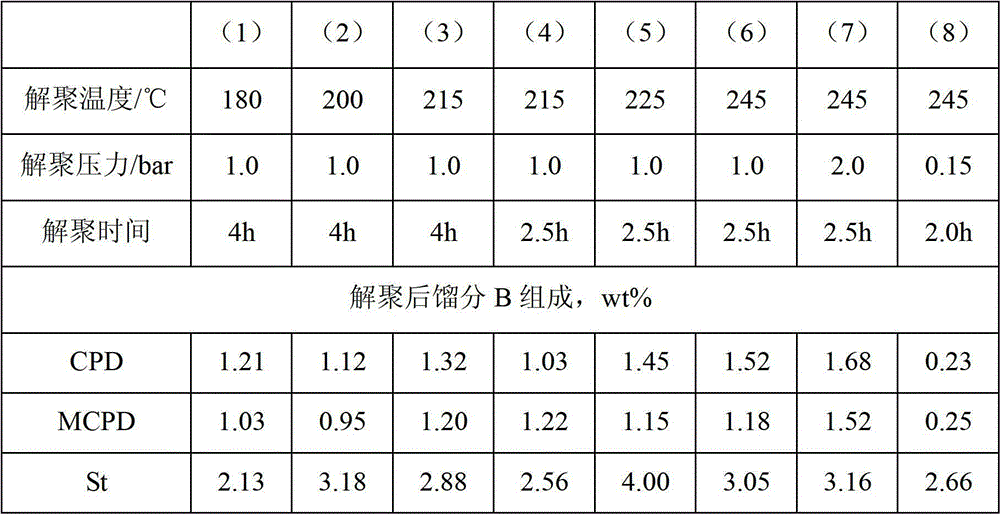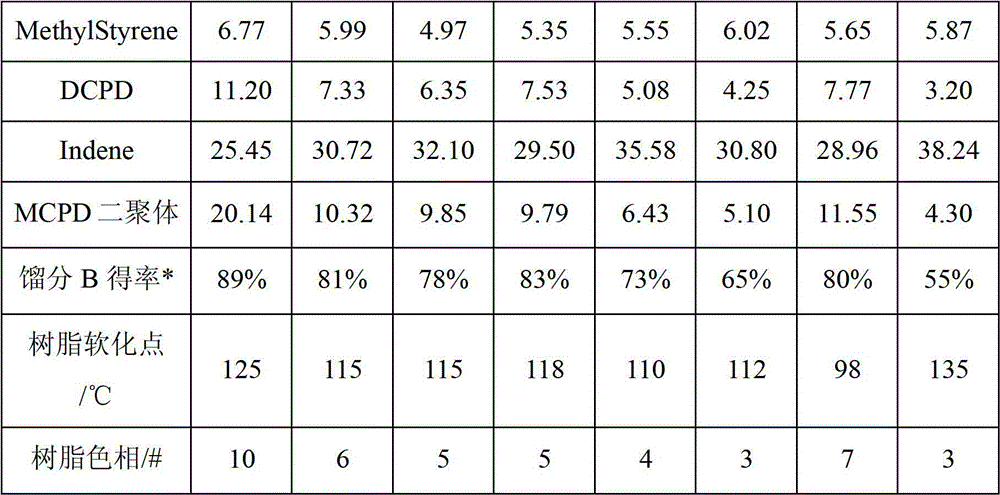Method for preparing cold-polymerized indene resin with high softening point and light color
A high softening point, indene resin technology, applied in application, coating, ink, etc., can solve the problems of unable to meet the high-end market demand, unable to obtain high-quality performance resin products, resin hue, poor compatibility, etc.
- Summary
- Abstract
- Description
- Claims
- Application Information
AI Technical Summary
Problems solved by technology
Method used
Image
Examples
Embodiment 1
[0067] The by-product C9 fraction of ethylene cracking is rectified under vacuum at -0.085MPa to intercept fraction A with a boiling point of 180-230°C, and then depolymerized and rectified in a depolymerization reactor at 0.10MPa and 240°C to obtain a fraction A with a boiling point of 180-230°C. Fraction B at 230°C had a depolymerization residence time of 3.5 hours. Fraction B was prepolymerized with 0.3wt% boron trifluoride ether catalyst at room temperature for 1.5 hours, then the catalyst was removed with a mixture of calcium hydroxide and methanol, and fraction C with a boiling point of 180-230°C was obtained by rectification.
[0068] Put the above-mentioned fraction C into a stirred reactor, slowly add boron trifluoride ether catalyst accounting for 1.5wt% of the total material mass at a temperature of -5°C for 1 hour, and then heat-preserve and polymerize at 25°C for 1.5 hours, to obtain a polymerization liquid; drop into the above-mentioned polymerization liquid into...
Embodiment 2
[0074] The by-product C9 fraction of ethylene cracking is rectified under vacuum at -0.085MPa to intercept fraction A with a boiling point of 180-230°C, and then depolymerized and rectified in the depolymerization reactor at 0.10MPa and 230°C to obtain a fraction A with a boiling point of 180-230°C. Fraction B at 230°C had a depolymerization residence time of 5 hours. Fraction B was prepolymerized with 0.3wt% boron trifluoride ether catalyst at room temperature for 1.5 hours, then the catalyst was removed with a mixture of calcium hydroxide and methanol, and fraction C with a boiling point of 180-230°C was obtained by rectification.
[0075]Put the above fraction C into a stirred reactor, slowly add boron trifluoride diethyl ether catalyst accounting for 1.0wt% of the total material mass at 0°C for 1 hour, and then heat-preserve and polymerize at 25°C for 2 hours, Obtain the polymerization liquid; drop into the above-mentioned polymerization liquid the calcium hydroxide of 3 t...
Embodiment 3
[0081] The by-product C9 fraction of ethylene cracking is rectified under vacuum at -0.085MPa to intercept the fraction A with a boiling point of 180-230°C, and then depolymerized and rectified in the depolymerization reactor at 0.08MPa and 230°C to obtain a fraction A with a boiling point of 180-230°C. Fraction B at 230°C had a depolymerization residence time of 6 hours. Fraction B was prepolymerized with 0.3wt% boron trifluoride ether catalyst at room temperature for 1.5 hours, then the catalyst was removed with a mixture of calcium hydroxide and methanol, and fraction C with a boiling point of 180-230°C was obtained by rectification.
[0082] Put the above-mentioned fraction C into a stirred reactor, slowly add boron trifluoride ether catalyst accounting for 0.8wt% of the total material mass at a temperature of 5°C, and add it for 1 hour, and then heat-preserve and polymerize at 25°C for 2 hours, Obtain the polymerization liquid; drop into the above-mentioned polymerization...
PUM
| Property | Measurement | Unit |
|---|---|---|
| Softening point | aaaaa | aaaaa |
| Softening point | aaaaa | aaaaa |
| Softening point | aaaaa | aaaaa |
Abstract
Description
Claims
Application Information
 Login to View More
Login to View More - R&D
- Intellectual Property
- Life Sciences
- Materials
- Tech Scout
- Unparalleled Data Quality
- Higher Quality Content
- 60% Fewer Hallucinations
Browse by: Latest US Patents, China's latest patents, Technical Efficacy Thesaurus, Application Domain, Technology Topic, Popular Technical Reports.
© 2025 PatSnap. All rights reserved.Legal|Privacy policy|Modern Slavery Act Transparency Statement|Sitemap|About US| Contact US: help@patsnap.com



